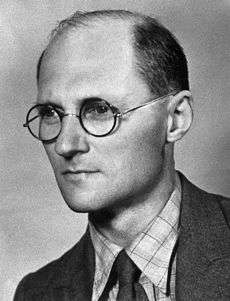Vincent Wigglesworth
| Sir Vincent Wigglesworth | |
|---|---|
|
Vincent Wigglesworth | |
| Born | 17 April 1899 |
| Died | 11 February 1994 (aged 94) |
| Nationality | British |
| Fields | Entomologist |
| Institutions | University of Cambridge |
| Doctoral students | Peter Lawrence |
| Known for | Metamorphosis hormones |
| Notable awards |
Royal Medal (1955) Fellow of the Royal Society |
Sir Vincent Brian Wigglesworth CBE FRS[1] (17 April 1899 – 11 February 1994) was a British entomologist who made significant contributions to the field of insect physiology.[2][3]
In particular, he studied metamorphosis. His most significant contribution was the discovery that neurosecretory cells in the brain of the South American kissing bug, Rhodnius prolixus, secrete a crucial growth hormone, prothoracicotropic hormone (PTTH), which regulates the process of metamorphosis.[4] This was the first experimental confirmation of the function of neurosecretory cells. He went on to discover another hormone, called the juvenile hormone, which prevented the development of adult characteristics in R. prolixus until the insect had reached the appropriate larval stage.[5] Wigglesworth was able to distort the developmental phases of the insect by controlling levels of this hormone. From these observations, Wigglesworth was able to develop a coherent theory of how an insect's genome can selectively activate hormones which determine its development and morphology.
Personal life
Wigglesworth served in the Royal Field Artillery in France in World War I. He received his degree from the University of Cambridge and lectured at the London School of Hygiene and Tropical Medicine, the University of London, and finally at the University of Cambridge.
He was named Quick Professor of Biology at the University of Cambridge in 1952, appointed CBE in 1951,[6] and knighted in 1964.[7]
Wigglesworth was President of the Association of Applied Biologists from 1966–1967.
The bacterium Wigglesworthia glossinidia, which lives in the guts of tsetse flies, is named for him.[8]
References
- ↑ Locke, M. (1996). "Sir Vincent Brian Wigglesworth, C. B. E. 17 April 1899-12 February 1994". Biographical Memoirs of Fellows of the Royal Society. 42: 540–526. doi:10.1098/rsbm.1996.0032.
- ↑ Edwards, J. S. (1998). "Sir Vincent Wigglesworth and the coming of age of insect development". The International journal of developmental biology. 42 (3): 471–473. PMID 9654033.
- ↑ Edwards, J. (1994). "Sir Vincent Brian Wigglesworth (1899-1994)". Developmental Biology. 166 (2): VI–. doi:10.1006/dbio.1994.1322.
- ↑ Wigglesworth, V.B. (1934). "The physiology of ecdysis in Rhodnius prolixus (Hemiptera). II Factors controlling moulting and metamorphosis". Quart. J. Microsc. Sci. 77: 191–223.
- ↑ J. A. V. Butler (1959). Inside the Living Cell. George Allen and Unwin. p. 79.
- ↑ The London Gazette: (Supplement) no. 39104. p. 12. 1 January 1951.
- ↑ The London Gazette: (Supplement) no. 43343. p. 4938. 13 June 1964.
- ↑ Aksoy, S (1995). "Wigglesworthia gen. Nov. And Wigglesworthia glossinidia sp. nov., taxa consisting of the mycetocyte-associated, primary endosymbionts of tsetse flies" (PDF). International Journal of Systematic Bacteriology. 45 (4): 848–51. doi:10.1099/00207713-45-4-848. PMID 7547309. Retrieved 23 July 2016.
External links
- Beament, James. Obituary: Professor Sir Vincent Wigglesworth, The Independent on Sunday, 1994-02-16
- Sir Vincent Wigglesworth papers, University of Cambridge Janus archive (subscription required)
- Works by or about Vincent Wigglesworth in libraries (WorldCat catalog)
